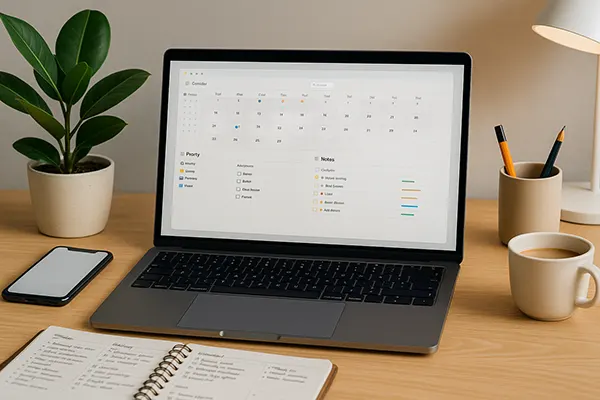Creating and Selling Digital Journals and Notion Templates as a Source of Passive Income

In recent years, digital journals and productivity templates — particularly those designed for Notion — have gained immense popularity. These digital products appeal to students, entrepreneurs, content creators, and people who want to optimise their lives. For creators, they offer a unique opportunity to build a scalable business model with minimal overhead. In this article, we explore how digital planners and Notion templates can become a reliable stream of passive income, using real market examples and proven strategies.
Understanding the Market for Digital Templates
Digital products such as Notion templates and daily planners have become a niche with consistent demand on Etsy, Gumroad, and independent creator shops. Users often look for pre-designed solutions that help them manage habits, goals, finances, or content calendars. This demand is particularly strong among Gen Z and millennial audiences familiar with Notion and similar tools.
In June 2025, the Notion template marketplace continues to thrive, with top sellers earning thousands of pounds monthly. Templates range from simple habit trackers to complex dashboards for business operations. Buyers prefer products that are easy to use, aesthetically pleasing, and provide tangible organisational benefits.
There’s also a growing trend for niche-focused planners — for example, digital journals for ADHD productivity, travel planning, or wellness tracking. By focusing on specific problems or audiences, sellers can stand out in a competitive environment and attract loyal buyers.
Why Notion Is Ideal for Template Monetisation
Notion allows full customisation without requiring coding skills, making it accessible for anyone willing to learn its interface. Creators can build professional-looking dashboards with tables, databases, linked views, and formulas. Templates can be duplicated easily by buyers and integrated into their own Notion workspace.
Another reason Notion stands out is its widespread usage among remote professionals, students, and online entrepreneurs. By solving specific problems (like content scheduling or personal finance tracking), templates become valuable tools that customers are willing to pay for.
Finally, Notion has an integrated sharing system, which makes it easy to distribute templates via a shareable link, reducing friction in the sales process and improving user experience.
How to Design and Launch Your First Digital Product
Begin by researching what types of templates are already popular and identify gaps in the market. Use Etsy, Reddit, Gumroad, or TikTok to understand what people are searching for. Focus on a narrow use case and create a clear structure. For example, a “small business income tracker” will serve a more specific need than a generic finance dashboard.
After planning the structure, use Notion to build the template step by step. Focus on clarity, visual consistency, and usability. If you’re creating a digital journal, use toggles, databases, and icons to keep the layout neat and engaging. Test the template with friends or a small audience to receive feedback before launching.
Once finalised, export or publish the template with a descriptive name and explanation. Create promotional visuals (screenshots, mockups) and list it on a storefront like Etsy or your own website. Use SEO-friendly titles and descriptions to help potential customers find your product.
Where to Sell and Promote Your Templates
Etsy remains a popular option due to its existing audience and search traffic. Gumroad and Payhip are alternatives that offer more control over pricing and customer communication. For long-term sustainability, consider building an email list or setting up a website to showcase all your products in one place.
Social media is a powerful tool for promotion. Many creators use Pinterest, TikTok, and Instagram to show how their templates work in real life. Short videos or carousels explaining the benefits of your template can significantly boost visibility and trust.
Affiliate programmes or partnerships with productivity influencers can also drive traffic to your templates. Providing free versions or simplified samples can help attract first-time users who later convert to paying customers.

How to Turn One Template into Ongoing Revenue
Unlike physical products, digital templates can be sold infinitely without replenishing stock. Once created, a single product can continue generating income as long as it remains relevant and discoverable. Updating the template periodically helps maintain its value over time.
Another effective strategy is bundling. Selling a group of related templates — such as a content calendar, budget tracker, and goal planner — increases perceived value and encourages higher order value. It also simplifies decision-making for the buyer.
Finally, consider upselling related services or products. For example, offering a customisation package, one-to-one Notion setup sessions, or a digital course on building templates can turn one-time customers into repeat clients. This combination of passive income and active services creates a sustainable business model.
Legal and Ethical Considerations
Even in digital sales, creators must comply with copyright laws. Never copy someone else’s template or design. Use original icons, text, and structures, or rely on public domain elements with proper attribution. Also, ensure your sales page clearly states what the customer will receive and how to access it.
Respect user data by not collecting information unnecessarily. If you decide to offer downloadable bonuses or email signups, include privacy notices and use secure systems for handling user info.
Finally, set fair pricing. Avoid undercutting the market, as it can devalue the work of creators in your niche. Focus instead on creating high-quality, unique products that justify their price tag.
